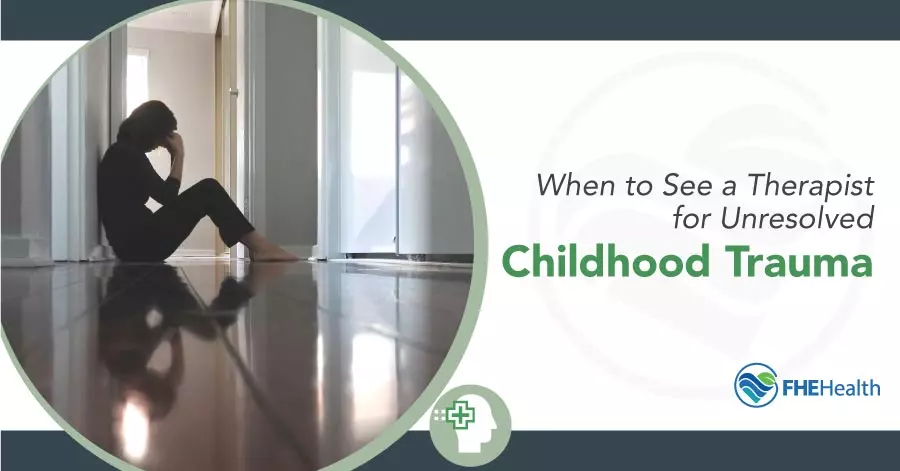
Childhood trauma refers to childhood experiences that negatively affect an individual’s emotional, physical, or mental health. Without addressing these experiences, unresolved trauma can lead to long-term mental health issues such as depression, anxiety, and post-traumatic stress disorder.
This article explores the sources of childhood trauma, how to know when it’s time to seek help, and what to look for in a therapist.
Understanding Childhood Trauma
Many people have traumatic experiences growing up. Particularly for those with a history of trauma, it’s important to understand how unresolved experiences can have a long-term effect.
Types of Childhood Trauma
The National Child Traumatic Stress Network lists 12 common types of childhood trauma. These include:
- Bullying. The term refers to the intentional and unsolicited act of inflicting harm on someone less powerful, especially children.
- Community violence. Children who witness intentional violence in the community can be affected by this type of trauma.
- Complex trauma. This refers to both the child’s exposure to more than one traumatic event and the long-term and wide-ranging effects of the trauma.
- Disasters. Early experiences with hurricanes, tornadoes, floods, earthquakes, wildfires, and other extreme weather events impact the individual’s sense of safety and security.
- Early childhood trauma. These traumatic experiences occur in children from the ages of birth to 6 years.
- Intimate partner violence. A child may witness harm inflicted on a parent by another parent or partner (intimate partner or domestic violence).
- Medical trauma. Medical procedures and illnesses that a child experiences may result in physiological and psychological trauma.
- Physical abuse. This includes a parent or other caregiver slapping, kicking, hitting, or neglecting a child.
- Refugee trauma. Being displaced from a home or country and forced to flee to unfamiliar areas can cause tremendous emotional uncertainty in a child.
- Sexual abuse. This trauma is perpetrated by an adult or a person older than the child. It is for the pleasure or benefit (sometimes financial) of the adult.
- Terrorism and violence. Shootings, bombings, and other types of violence can have lasting negative effects.
- Traumatic grief. This occurs when someone close to the child dies, such as a parent or sibling.
Effects of Childhood Trauma
Childhood trauma can have a significant long-term impact on the individual’s brain and body. According to a 2023 study, this exposure causes significant changes in the brain, impacting everything from its structure and how it processes new information to immune systems and personality development.
In response to trauma, the individual may develop mental health issues such as depression and PTSD, and they might maintain high levels of cortisol and adrenaline.
Trauma can also lead to long-term emotional dysregulation. The individual may have intense mood swings and difficulty controlling anger, or they may have ongoing feelings of numbness or detachment. This can make it difficult for them to form relationships.
Signs You May Need to See a Therapist
No matter how long ago the trauma occurred, it’s never too late to benefit from professional help. Certain mental, behavioral, and physical signs can indicate that you may need therapy for childhood trauma.
Emotional and Mental Health Indicators
- Persistent emotional symptoms, including mood swings or difficulty regulating feelings of anger
- Ongoing feelings of guilt, shame, or low self-esteem
- Frequent anxiety, panic attacks, or depression
- Overwhelming emotional responses to minor triggers
- Intrusive thoughts or flashbacks
- Feelings of emptiness or disconnection
- Sudden emotional reactions to certain situations, places, or people
Behavioral and Relational Red Flags
- Difficulty maintaining relationships
- Self-destructive habits, such as substance use or risk-seeking behaviors
- Avoidance of emotional intimacy or vulnerability
- Difficulty maintaining employment or responsibilities
Physical and Somatic Clues
- Chronic pain, fatigue, or muscle tension
- Ongoing digestive issues or unexplained illnesses
- Recurring intrusive thoughts or nightmares
- Disordered eating patterns
The Role of Therapy in Healing Childhood Trauma
For those who’ve experienced trauma during childhood, addressing the ongoing physical, psychological, and emotional effects can be life-changing. While education and self-help strategies play an important role in the healing process, seeing a therapist is vital for learning to cope.
Benefits of Working with a Therapist
Emotional Processing and Healing
During therapy for unresolved childhood trauma, therapists help individuals put their experiences into the correct context. This may include helping the individual recognize that they were not responsible for an adult’s behavior or realize that they were not accountable for their family’s safety in dangerous circumstances.
Developing Coping Strategies
Years or even decades after the trauma occurs, individuals often experience anxiety, anger, and emotional dysregulation. During therapy, they learn helpful strategies for dealing with strong emotions. This lets them regain control over their emotional responses, build healthier relationships, and improve their overall well-being.
Improving Relationships and Communication
Because trauma can affect how the brain perceives potential threats, many people who’ve experienced trauma in childhood have difficulty maintaining relationships. Therapy can help them overcome unhealthy attachment issues and trust problems.
Enhancing Overall Well-being
Going to therapy can help individuals understand and process traumatic experiences, leading to greater self-awareness of how these experiences shape their personality, strengths, thoughts, and behaviors. By developing strategies for dealing with strong emotions, building healthy relationships, and overcoming the lingering psychological effects of trauma, individuals can strengthen their emotional resilience.
Types of Therapy Commonly Used
Together with the trained and certified trauma therapist, determine which types of therapies are best suited to learning how to heal from childhood trauma. Several therapies may be helpful, including:
- Trauma-focused CBT, or cognitive processing therapy
- Dialectical behavioral therapy
- Eye Movement Desensitization and Reprocessing (EMDR)
- Exposure therapy, or prolonged exposure therapy
- Somatic experiencing
When to Consider Therapy
When childhood trauma impacts an individual’s ability to lead a healthy, happy, and productive life, it’s important to seek help.
Personal Realizations and Triggers
The experience of childhood trauma can last long after the individual enters adulthood. Researchers studying the long-term effects of childhood trauma point to problems with depression and anxiety stemming from the trauma. Adults who don’t know how to heal from childhood trauma may turn to alcohol or drugs to help numb the painful memories. This can lead to substance abuse and mental health disorders that require professional trauma treatment to overcome.
Other manifestations of childhood trauma in adulthood include difficulties with social interaction, multiple health problems, low self-esteem, and a lack of direction. Adults with unresolved childhood trauma are also more prone to PTSD, suicide, and self-harm.
External Feedback and Life Disruption
In some cases, the clearest insight into the need for professional help doesn’t come from the individual’s self-analysis, but from the way their childhood trauma affects those around them.
For example, friends, family, and intimate partners may mention changes in mood or behavior. While this kind of feedback can be difficult to hear, it may indicate deep emotional wounds are beginning to surface. If an individual is regularly told that they’re distant or reactive, it may be time to reflect on whether childhood trauma is playing a role in how they interact with others.
Trauma can also affect the individual’s ability to concentrate on tasks and tolerate stress. They may struggle with work deadlines, interpersonal conflicts, or burnout disproportionate to their workload. These challenges don’t reflect a personal weakness; they may point to deeper emotional pain that therapy can help with.
Overcoming Barriers to Seeking Help
Recognizing the need for therapy is an important milestone, but taking the next step can be a challenge. Many people who’ve experienced childhood trauma have a difficult time overcoming their own beliefs about themselves, as well as logistical barriers to treatment. Understanding these barriers can help individuals learn to navigate them and begin the healing process.
Common Internal Obstacles
Despite progress in raising awareness, mental health stigma still exists in many communities. Individuals may feel embarrassed to admit they’re struggling, with an internalized belief that asking for help is a sign of weakness or failure. In reality, reaching out for help is an act of strength and a sign the individual values their well-being.
Additionally, many people are reluctant to seek therapy because they don’t want to talk about the trauma they experienced. Re-examining the past can feel scary and overwhelming. However, professional counselors are trained to help their clients move through painful memories at a pace that feels manageable, offering support to avoid retraumatization.
Practical Concerns
Especially for someone who’s never sought therapy, knowing where to begin can feel daunting. When looking for the right therapist, it’s important to focus the search on those who specialize in trauma and use modalities such as EMDR, somatic therapy, or inner child work.
Additionally, therapy requires a financial investment, especially without insurance. However, many therapists and treatment centers make care accessible through sliding-scale fees and flexible payment options.
Finally, for people with busy schedules, setting aside even one hour for therapy every week can seem impossible. However, the long-term benefits of therapy outweigh short-term inconveniences. Individuals often discover improved productivity, reduced emotional turmoil, and more meaningful relationships.
The effects of childhood trauma can linger for years or decades after the danger has passed, impacting the individual’s physical, psychological, and mental health. Regardless of the nature of the trauma or how long ago it occurred, it’s never too late to benefit from professional help.
Find help to overcome childhood trauma by contacting our experts at FHE Health. We’re here to assist in how to heal from childhood trauma and how to get back to living the life you deserve.






